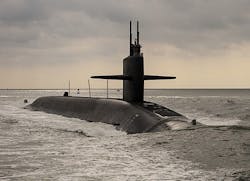Lockheed Martin to upgrade Navy submarine sonar signal processing gear in $122.3 million order
WASHINGTON –Submarinesonar experts at Lockheed Martin Corp. are moving forward to keep digital signal processing capability aboard U.S. Navy submarines up-to-date through the year 2020.
Officials of the Naval Sea Systems Command in Washington announced a $122.3 million order Monday for engineering work involving the Acoustics-Rapid COTS Insertion (A-RCI) program's technical insertions (TI) 18 to 20.
The A-RCI program seeks to improve acoustic sensing aboard U.S. fast-attack, cruise-missile, and ballistic-missile submarines without changing the sonar transducer sensors through the rapid insertion of commercial off-the-shelf (COTS)-based digital signal processing hardware.
Monday's order is a modification to a potential $1.2 billion contract announced last June for A-RCI TI 18 to 20 engineering work. In last May's contract Lockheed Martin received an initial $130.8 million.
By upgrading ship sensor processing, A-RCI will integrate improve submarine towed-array, hull-array and sphere-array sonar sensors arrays. A-RCI technology insertions describe biannual computer hardware upgrades. Periodic software upgrades are called advanced processor builds (APBs).
The Navy began the Acoustics-Rapid COTS Insertion (A-RCI) program in the late 1990s as a way to capitalize on commercial off-the-shelf (COTS) rugged server and embedded computing technology to make quick periodic upgrades of submarine sonar signal processing capability.
Lockheed Martin is working on the A-RCI program as prime contractor, together with computer equipment supplier Germane Systems in Chantilly, Va.
An open-systems architecture makes the most of commercial processing development, and enables submarine signal processing systems to use complex algorithms that Navy-developed sonar systems such as the AN/BSY-1 and AN/BSY-2 systems could not use.
Related: Navy asks Lockheed Martin to upgrade sonar signal processing on submarine and fixed sites
The A-RCI program seeks to move the latest COTS digital signal processing technology into submarine signal processing systems aboard Virginia-, Seawolf-, and Los Angeles-class fast attack submarines, as well as aboard Ohio-class missile submarines on a regular basis to keep pace with commercial embedded computing developments.
A-RCI is an open architecture sonar system that Navy officials intend to maintain an advantage in acoustic detection of threat submarines, using legacy sonar sensors. The program regularly refreshes central processors with COTS computer technology and software. A-RCI processors handle data from the submarine’s spherical array, hull array, wide aperture array, high-frequency arrays, and towed arrays.
On Monday's order Lockheed Martin is doing the work in Manassas, Va. and Clearwater, Fla., and should be finished by December 2018. The original contract was for the U.S. Navy, as well as for the navies of Canada, Australia, the United Kingdom, and Japan.
For more information contact Lockheed Martin Rotary and Mission Systems online at www.lockheedmartin.com/us/rms.html, Germane Systems at www.germane.com, or Naval Sea Systems Command at www.navsea.navy.mil.
Ready to make a purchase? Search the Military & Aerospace Electronics Buyer's Guide for companies, new products, press releases, and videos

